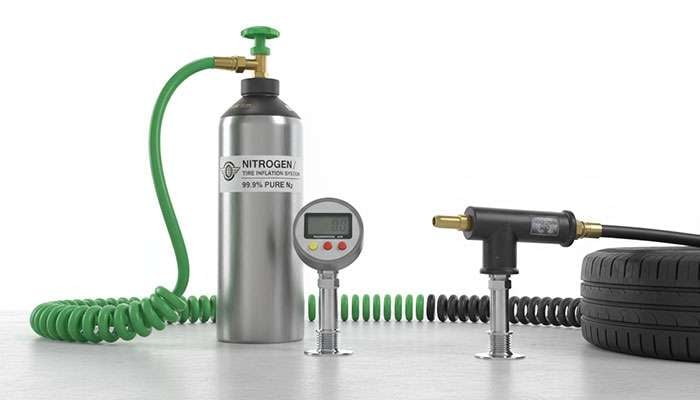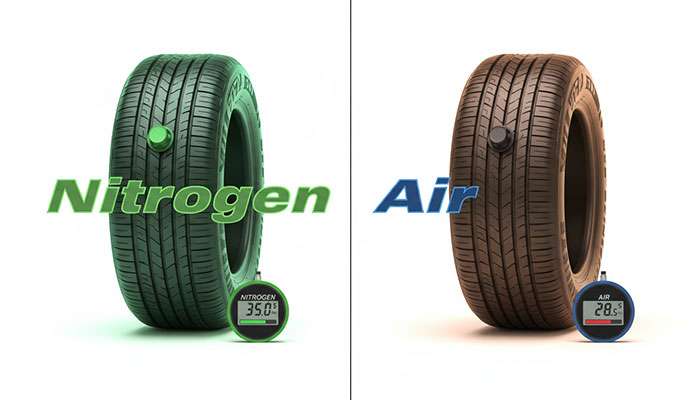
Can you safely add regular air to nitrogen-filled tires when they're running low on pressure? The answer is absolutely yes. Despite widespread confusion about this topic, mixing regular air with nitrogen poses no safety concerns or tire damage.
This common misconception has left many drivers stranded unnecessarily. Here's what you need to know: regular compressed air already contains 78% nitrogen. For nitrogen to provide its maximum benefits, your tires need a concentration of 93% or higher. When you add regular air to nitrogen-filled tires, you're simply diluting the nitrogen percentage, reducing its effectiveness while keeping your tires perfectly functional.
The science behind nitrogen's appeal lies in molecular size. Nitrogen molecules are larger than oxygen molecules, making them less likely to seep through your tire's rubber walls. This property explains why many vehicle owners choose nitrogen inflation for better pressure retention.
We'll break down everything you need to understand about nitrogen versus air in tires, what happens when you mix them, and how these choices affect your vehicle's performance and maintenance needs.

The composition differences between nitrogen and regular air tell the complete story. Regular air contains approximately 78% nitrogen, 21% oxygen, and 1% other gasses. Pure nitrogen inflation, on the other hand, typically achieves 95-99% nitrogen concentration.
Laboratory testing reveals nitrogen's performance advantage. Tires inflated with nitrogen lost pressure at about two-thirds the rate of air-filled tires. The numbers speak for themselves: air-filled tires lost an average of 2.13% pressure per month, while nitrogen-filled tires lost only 1.39% per month.
Nitrogen's chemical properties provide additional benefits beyond slower pressure loss. As an inert gas, nitrogen doesn't support moisture or combustion. This characteristic helps prevent internal tire oxidation, which can make rubber brittle over time. Temperature stability represents another key advantage—tire pressure can rise or fall approximately 1 psi for every 10°F change in ambient temperature.
These performance characteristics explain nitrogen's widespread use in demanding applications. Aircraft, mining equipment, commercial vehicles, and professional auto racing all rely on nitrogen inflation. Race car teams particularly value nitrogen's ability to maintain consistent pressure even at extreme speeds.
For everyday driving, however, the practical difference may be less dramatic. A Consumer Reports study found only a 1.3 psi difference in pressure loss between nitrogen and air-filled tires over an entire year. This data suggests that while nitrogen offers measurable benefits, the real-world impact for typical drivers remains modest.

Picture this: you're halfway through a road trip when you notice one of your nitrogen-filled tires looking low. The gas station ahead has air pumps but no nitrogen service. What's your move?
You can absolutely add regular air to nitrogen-filled tires without any safety concerns. No harmful chemical reactions will occur, and your tires won't suffer damage from mixing these compatible gases. The combination is completely safe.
However, adding air does come with trade-offs. When you introduce regular air, you're diluting the nitrogen concentration, which reduces its pressure-retention advantages. Remember, tires need roughly 93-95% nitrogen concentration to deliver optimal benefits.
Some tire professionals caution against mixing because oxygen can introduce moisture over time, gradually reducing nitrogen's effectiveness. This process happens slowly but does compromise the pure nitrogen benefits you originally invested in.
Here's our practical recommendation: if you're serious about maintaining nitrogen's advantages, stick with nitrogen-only top-offs whenever possible. But when you're facing low tire pressure and nitrogen isn't available, don't hesitate to use regular air. Many drivers occasionally mix the two without noticing performance differences, especially for temporary solutions.
The key is understanding your priorities. Proper tire pressure matters more than gas purity for immediate safety and performance.
Deciding whether to mix air and nitrogen requires understanding both the practical advantages and potential limitations of this approach.
Emergency Convenience: Regular air provides immediate relief when you're facing low tire pressure and nitrogen isn't available. Gas stations with standard air pumps are everywhere, while nitrogen filling stations remain relatively scarce. Most importantly, properly inflated tires with mixed gases perform far better than underinflated tires with pure nitrogen.
Performance Trade-offs: Mixing air with nitrogen reduces the concentration below the optimal 93-95% threshold, which decreases nitrogen's pressure retention advantages. Pure nitrogen loses pressure at approximately 1.39% per month compared to regular air's 2.13% monthly loss. When you mix the two, you'll fall somewhere between these rates.
Budget Impact:Nitrogen inflation costs $5-$30 per tire initially, with refills running $5-$7 per tire. Regular air typically costs nothing or just a few quarters at most stations. Frequent air top-offs essentially eliminate the cost benefits you paid for with nitrogen installation.
Long-Term Considerations:Maintaining nitrogen purity above 90% delivers maximum benefits. However, most everyday drivers won't notice significant performance differences with mixed gases unless they're operating high-performance vehicles or driving in extreme conditions.
The bottom line: if you've invested in nitrogen, try to maintain it. If you find yourself regularly adding air, switching entirely to conventional inflation might prove more practical and economical.
Proper tire inflation matters more than the type of gas you choose. The decision between nitrogen and regular air comes down to your specific driving needs and budget priorities.
Regular air works perfectly well for most drivers. Nitrogen offers modest advantages for those who want maximum pressure retention and reduced maintenance frequency. The key point is this: you can safely mix the two gases without any safety concerns or tire damage.
We understand that many drivers worry about "ruining" their nitrogen investment by adding regular air during emergencies. This concern is unnecessary. While mixing does reduce nitrogen's effectiveness, it won't harm your tires or create dangerous conditions.
The cost difference tells an important story. Nitrogen typically runs $5-$30 per tire initially, with refills costing $5-$7 per tire. Regular air is usually free or costs just a few quarters. If you frequently find yourself topping off with regular air, you're essentially paying premium prices for standard performance.
Here's our recommendation: if you've already invested in nitrogen inflation, stick with it when possible to get your money's worth. However, if nitrogen isn't available and your tire needs air, don't hesitate to use regular air. Your safety matters more than gas purity.
For drivers who regularly add air instead of nitrogen, switching entirely to conventional inflation might make more practical and economic sense. The most important factor is maintaining proper tire pressure consistently - this impacts fuel economy, tire wear, and vehicle safety far more than obsessing over gas composition.
At the end of the day, choose the option that fits your driving habits, maintenance schedule, and budget. Both nitrogen and regular air will keep you rolling safely down the road.
Here are the essential insights every driver should know about mixing air and nitrogen in tires:
• It's completely safe to add regular air to nitrogen-filled tires - no harmful reactions occur, making it perfect for emergency situations when nitrogen isn't available.
• Mixing reduces nitrogen effectiveness but doesn't eliminate benefits - nitrogen concentration drops below the optimal 93-95% threshold, but tires remain functional and safe.
• Regular air already contains 78% nitrogen - you're not introducing a completely foreign substance, just diluting the purity that provides nitrogen's pressure-retention advantages.
• Cost-benefit analysis matters for most drivers - nitrogen costs $5-$30 per tire initially while air is often free, so frequent air top-offs may negate your nitrogen investment.
• Proper tire pressure trumps gas type - maintaining recommended PSI levels impacts fuel economy, tire wear, and safety far more than obsessing over nitrogen purity.
The bottom line: while nitrogen offers modest advantages like slower pressure loss (1.39% vs 2.13% monthly), the practical difference for everyday driving is minimal. Focus on consistent pressure maintenance rather than gas purity for optimal tire performance and safety.
Yes, it's completely safe to add regular air to nitrogen-filled tires. There's no harmful chemical reaction, and the mixture is compatible. However, it will dilute the nitrogen concentration, potentially reducing some of its benefits.
Mixing air with nitrogen slightly reduces the benefits of pure nitrogen inflation, such as slower pressure loss and reduced temperature sensitivity. However, the impact on everyday driving is minimal for most vehicles.
Nitrogen-filled tires typically lose pressure more slowly (about 1.39% per month compared to 2.13% for air), are less affected by temperature changes, and may help prevent internal tire oxidation over time.
Initial nitrogen inflation usually costs between $5-$30 per tire, with refills around $5-$7 per tire. Regular air is often free or costs just a few cents. The cost difference should be considered when deciding between the two options.
If you frequently find yourself adding regular air to your nitrogen-filled tires, it might be more practical and economical to switch entirely to conventional air inflation. The most important factor is maintaining proper tire pressure, regardless of the gas used.